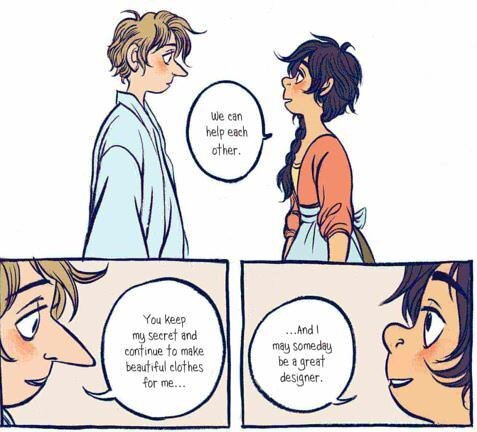The Prince and the Dressmaker by Jen Wang tells the story of Frances, a young seamstress from Paris, and Sebastian, the crown prince of Belgium. With Frances’s bold designs, Sebastian transforms into the beautiful and elegant Lady Crystallia, allowing Sebastian to take the streets of Paris by storm and Frances to have her designs proudly showcased. However, both of them must keep Lady Crystallia’s true identity a secret as the world is not ready for a prince who likes dressing as a princess.
What is the foundation of Frances and Sebastian’s immediate friendship?
She’s a seamstress, and he is the crown prince of Belgium. There are countless stories that start similarly, with this odd-couple dynamic of clashing social status and upbringing. And yet, despite the tried and true conventions of trope - playful annoyance, misunderstandings, the teachings of compromise - Frances and Sebastian hit it off pretty quickly. It is obvious to see that there is more beneath the employer-employee relationship that both parties thought this would be. Sebastian had no way of knowing the bold seamstress he hired was a young woman around his age, with big ideas and even bigger dreams. Frances could only have had an inkling that her mystery employer was wealthy and certainly a woman because was there any other possibility? Once the literal veil fell, a stronger force fostered their relationship.
Credit: Jen Wang
A five-panel page.
First panel: A close-up of Sebastian’s hand as he sets another fashion illustration on the table, on top of a few others scattered around.
Second panel: Sebastian holds another illustration close to his face to take a better look.
Sebastian: What made you want to be a designer?
Third panel: Frances is sitting at a table as she is about to start an illustration. Her eyes are looking down at the paper.
Frances: The first time I came to the city, I came with my mother to deliver goods for her employer.
Fourth panel: A background of a bustling city, a young Frances is looking back at something as she walks hand-in-hand with her mother, who is carrying a basketful of clothes. The panel is colored in varying shades of brown to illustrate a flashback.
Fifth panel: A partial close-up of a show poster, giving the impression it was caught in a glance. Below the header, there is a figure of a woman in a big, flowering white dress. The woman seems to be dancing on the page.
Frances: When we passed the Grand Music Hall, I saw a poster for a ballet called “The Muse of Crystallia.” I couldn’t stop looking at it. For weeks afterward I kept drawing versions of that poster, trying to imagine what the costumes really looked like.
Credit: Jen Wang
A four-panel page.
First panel: A young Frances is lying on her stomach on the floor. Her left hand is propping her head up as she draws a ballerina. Other drawings and pencils are littered around her.
Frances: Eventually I stopped drawing Crystallia and just started making up costumes for my own imaginary ballets.
Second panel: A close-up of young Frances’s drawing and her pencil as she adds details.
Frances: At some point I realized this was a real job somebody had and I wanted to be that person. The person who makes beautiful things.
Third panel: A present-day Frances is holding up an illustration for Sebastian to see.
Frances: What do you think of this?
Fourth panel: A wide shot of the room with the fireplace and mantlepiece in the background. Sebastian, illustration in one hand and another on his face, is judging Frances’s work. Frances is across from him, waiting for his opinion. Both figures are silent.
Despite the sudden surprise of their true identities, particularly Sebastian’s, both he and Frances realized they are both on a journey of self-fulfillment, of outwardly expressing the beauty they both hold within. Designing and wearing beautiful gowns is the perfect way of achieving this. On pages 45 and 46, Frances explains to Sebastian what initially drew her to designing. She was initially drawn to the beauty of the poster which sparked her imagination. Her desire to see more beauty in the world nurtured her creativity to produce that beauty for herself. The eventual realization that people can actually produce beauty for a living then brought that dream into a more actual sense. This is a path she could strive for. This perfectly coincides with Sebastian’s desires of expressing who he is and of breaking free of gender norms and expectations through the achievement of beauty. Beauty is both the means and the goal for both of them.
Credit: Jen Wang
A three-part page.
First panel: Sebastian and Frances are standing close together, looking at each other.
Frances: We can help each other.
Second panel: A profiled close-up of Sebastian’s face, facing right.
Sebastian: You keep my secret and continue to make beautiful clothes for me…
Third panel: A profiled close-up of Frances’s face, facing left.
Frances: …And I may someday be a great designer.
The kind of strong, sudden bond between Frances and Sebastian is exemplary of another trope-like dynamic: the friendship between queer men and non-queer women. While some might argue that it borderlines on cliché, the fact of the matter is that many queer men owe a great deal to wonderful women who not only accepted them for who they were, but also helped them express who they were without fear. By having found Frances, Sebastian is able to wear the clothes that bring him comfort, confidence and freedom from the expectations set by his status. In turn, Frances found a patron for her creative aspirations and a clearer path to her dreams; however, in a less transactional way, she also found a nurturing friend that whole-heartedly appreciates her for who she is.


